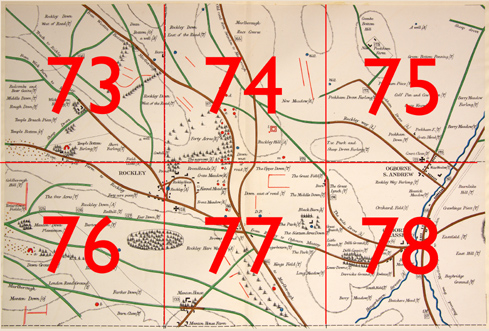AC Smith Maps: Map M. Squares 74 to 78
Square 73:
a. Mutilated Kistvaen. "This once-honoured tomb lay in the centre of the valley known as Temple Bottom". For many years it had been partly broken up and its stones carried away, the rest covered by field clearance stones. Smith describes his 1861 excavation, assisted by Reverends Lukis and Tanner; they found a "sepulchral chamber, guarded by a circle of upright stones, some of them in position." On the floor of the chamber was a layer of charcoal, with unburnt bones, parts of a human skull and teeth and pottery. More remains were found, and a "well-formed and perfect bone chisel". Smith concludes: "I regret to say that this kistvaen is now entirely swept away and even the exact site of it is uncertain."
b. Very low wide-spreading barrow. No ditch, opened at top.
c. Very low, indistinct bowl-shaped barrow. No ditch, opened at top.
Square 74:
Smith describes the Rockley barrows, which form a long line, and relates how the landowner gave permission in for several to be opened in 1879. The work was directed by William Cunnington and his son, attended by Smith and other antiquaries of the Wiltshire Archaeological Society.
a. Low bowl-shaped barrow, spread over a wide area, no ditch. Opened by a trench; just below the turf was a skeleton, disturbed by a previous opening. A beautiful leaf-shaped flint arrow-head was found. Two feet from this was a layer of small sarsens, covering an internment of burnt bones and wood ash. An inverted urn was found, covering a cist cut into the chalk; the urn was full of burnt human bones. A fine flint knife and scraper were also found.
b. Bowl-shaped barrow, no ditch, opened before.
c. Small low bowl-shaped barrow with ditch around. Opened by a trench. Fragments of a drinking cup were found, but no internment with it. At ground level a cist was found, cut into the chalk and filled with burnt bones and ashes but no pottery or other remains.
d. Tall and handsome bell-shaped barrow with large ditch; opened at top.
e. Very wide-spreading barrow, low from ploughing. A carter related that the plough once struck a stone in it: below was a hollow place big enough to hold a plough.
f. Large barrow in plantation, covered with trees. When opened in 1879 only marks of cremation were found.
g. Large barrow in the same plantation, also covered with trees. Opened in 1879: nothing of interest found.
h. Large barrow, covered with trees, in the same plantation.
i. Large barrow, covered with trees, in the same plantation.
k. Low tumulus, covered with trees, in the same plantation. Perhaps not a barrow.
l. Square earthwork, surrounded by bank and ditch.
m. Small low bowl-shaped barrow, no ditch, apparently not opened.
Square 75:
a. Large unshapely tumulus in the churchyard of Ogbourne St Andrew. Probably a barrow; no ditch, not opened.
Square 76:
a. Fallen kistvaen. "Parts of the mound which once covered it, and some of the stones which apparently surrounded it, are still to be seen. When Smith first saw it "some 25 years ago" the massive capstone was entire, but one of its supporters gave way and it fell. Smith then visited "about 14 years since" to discover some workmen who had just split the capstone and were about to break it up. Smith stopped the work by contacting the landowner.
b. Very low barrow, opened at top.
Square 77:
a. Very low bowl-shaped barrow, part cut away with large hole in one side.
b. Large bowl-shaped barrow, excavated in 1879 by AC Smith and Cunnington. In the centre was a cairn of large sarsens, 20 ft across - some weighed 3 or 4 cwt. Three internments were found, one primary and two secondary. In the middle of the cairn were two urns containing burnt bones and food-cups. One urn was placed in a small chamber of sarsens, like a miniature kistvaen. At the base was a cist, lined and covered with sarsens, containing a crouched skeleton.
c. Bowl-shaped barrow, not opened.
d. Large bowl-shaped barrow, not opened.
e. Bowl-shaped barrow.











